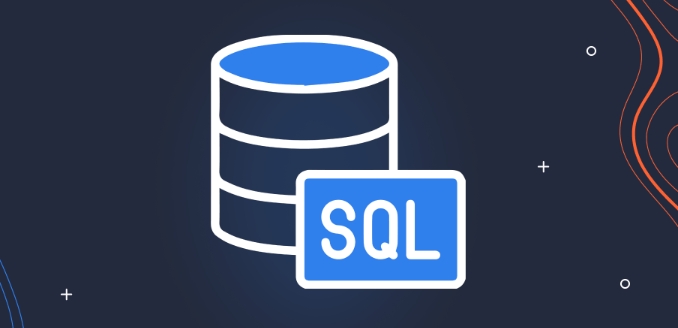Handling JSON data types in modern SQL databases can optimize performance by defining JSON columns, querying with specific functions, and creating indexes. First, you can define a JSON type column in the table, such as the JSON type of MySQL or the JSONB of Postgres; second, after inserting the standard JSON format data, you can extract the data through operators, such as Postgres uses @> to find the data containing "dev", and MySQL uses JSON_CONTAINS to achieve similar functions; third, to improve query performance, expression index or virtual columns can be created, such as Postgres creates an index through metadata->>'name', and MySQL adds virtual fields and creates an index; finally, when modifying the internal fields of JSON, Postgres can use jsonb_set to update the name, and MySQL uses JSON_SET or JSON_REPLACE to complete the corresponding operations.

Handling JSON data types in modern SQL databases is actually simpler than imagined, especially in mainstream systems such as Postgres, MySQL and SQL Server, it has been supported more thoroughly. Although it is not as intuitive as traditional fields, it can be flexible to deal with semi-structured data with the right method.

How to store and query JSON fields
Most modern databases allow you to define a column of type JSON in a table. For example, in MySQL you can use the JSON type, and in Postgres, you usually use JSONB (the binary format is more efficient).
Just write standard JSON format when inserting:

INSERT INTO users (id, metadata) VALUES (1, '{"name": "Alice", "tags": ["dev", "admin"]}'); When querying, it depends on how you extract the data. For example, to check whether tags contain "dev", Postgres can use @> operator:
SELECT * FROM users WHERE metadata @> '{"tags": ["dev"]}'; MySQL is via JSON_CONTAINS :

SELECT * FROM users WHERE JSON_CONTAINS(metadata, '"dev"', '$.tags');
Although these operations are syntax different, they are logically the same: specify the path and then match the value.
How to index JSON fields to improve performance
It is not efficient to directly index the entire JSON field, so expression indexes or virtual columns are generally created to optimize commonly used query fields.
For example, if you want to query users based on name frequently, you can create an index in Postgres like this:
CREATE INDEX idx_users_name ON users ((metadata->>'name'));
MySQL is a bit more complicated, so you need to add a virtual field first:
ALTER TABLE users ADD COLUMN user_name VARCHAR(255) GENERATED ALWAYS AS (JSON_UNQUOTE(JSON_EXTRACT(metadata, '$.name'))) STORED; CREATE INDEX idx_users_name ON users(user_name);
In this way, even if the data is in JSON, it can be searched quickly like ordinary fields.
Tips for modifying JSON data
To update a field inside JSON, you don’t need to take out the entire JSON and change it again. The database basically provides modification functions.
For example, if you want to change the name in Postgres:
UPDATE users SET metadata = jsonb_set(metadata, '{name}', '"Bob"') WHERE id = 1; MySQL uses JSON_SET or JSON_REPLACE :
UPDATE users SET metadata = JSON_SET(metadata, '$.name', 'Bob') WHERE id = 1;
If you just add an array element or delete a certain field, there are also corresponding functions, such as JSON_ARRAY_APPEND , JSON_REMOVE , etc.
Overall, SQL database support for JSON is already very practical, especially when you need flexible structures and don't want to completely migrate to NoSQL. As long as you pay attention to indexing and extract fields reasonably, it is not difficult to use. Basically that's it.
The above is the detailed content of Working with JSON data types in modern SQL databases.. For more information, please follow other related articles on the PHP Chinese website!

Hot AI Tools

Undress AI Tool
Undress images for free

Undresser.AI Undress
AI-powered app for creating realistic nude photos

AI Clothes Remover
Online AI tool for removing clothes from photos.

Clothoff.io
AI clothes remover

Video Face Swap
Swap faces in any video effortlessly with our completely free AI face swap tool!

Hot Article

Hot Tools

Notepad++7.3.1
Easy-to-use and free code editor

SublimeText3 Chinese version
Chinese version, very easy to use

Zend Studio 13.0.1
Powerful PHP integrated development environment

Dreamweaver CS6
Visual web development tools

SublimeText3 Mac version
God-level code editing software (SublimeText3)

Hot Topics
 OLTP vs OLAP: What Are the Key Differences and When to Use Which?
Jun 20, 2025 am 12:03 AM
OLTP vs OLAP: What Are the Key Differences and When to Use Which?
Jun 20, 2025 am 12:03 AM
OLTPisusedforreal-timetransactionprocessing,highconcurrency,anddataintegrity,whileOLAPisusedfordataanalysis,reporting,anddecision-making.1)UseOLTPforapplicationslikebankingsystems,e-commerceplatforms,andCRMsystemsthatrequirequickandaccuratetransactio
 How Do You Duplicate a Table's Structure But Not Its Contents?
Jun 19, 2025 am 12:12 AM
How Do You Duplicate a Table's Structure But Not Its Contents?
Jun 19, 2025 am 12:12 AM
Toduplicateatable'sstructurewithoutcopyingitscontentsinSQL,use"CREATETABLEnew_tableLIKEoriginal_table;"forMySQLandPostgreSQL,or"CREATETABLEnew_tableASSELECT*FROMoriginal_tableWHERE1=2;"forOracle.1)Manuallyaddforeignkeyconstraintsp
 What Are the Best Practices for Using Pattern Matching in SQL Queries?
Jun 21, 2025 am 12:17 AM
What Are the Best Practices for Using Pattern Matching in SQL Queries?
Jun 21, 2025 am 12:17 AM
To improve pattern matching techniques in SQL, the following best practices should be followed: 1. Avoid excessive use of wildcards, especially pre-wildcards, in LIKE or ILIKE, to improve query efficiency. 2. Use ILIKE to conduct case-insensitive searches to improve user experience, but pay attention to its performance impact. 3. Avoid using pattern matching when not needed, and give priority to using the = operator for exact matching. 4. Use regular expressions with caution, as they are powerful but may affect performance. 5. Consider indexes, schema specificity, testing and performance analysis, as well as alternative methods such as full-text search. These practices help to find a balance between flexibility and performance, optimizing SQL queries.
 How to use IF/ELSE logic in a SQL SELECT statement?
Jul 02, 2025 am 01:25 AM
How to use IF/ELSE logic in a SQL SELECT statement?
Jul 02, 2025 am 01:25 AM
IF/ELSE logic is mainly implemented in SQL's SELECT statements. 1. The CASEWHEN structure can return different values ??according to the conditions, such as marking Low/Medium/High according to the salary interval; 2. MySQL provides the IF() function for simple choice of two to judge, such as whether the mark meets the bonus qualification; 3. CASE can combine Boolean expressions to process multiple condition combinations, such as judging the "high-salary and young" employee category; overall, CASE is more flexible and suitable for complex logic, while IF is suitable for simplified writing.
 How to get the current date and time in SQL?
Jul 02, 2025 am 01:16 AM
How to get the current date and time in SQL?
Jul 02, 2025 am 01:16 AM
The method of obtaining the current date and time in SQL varies from database system. The common methods are as follows: 1. MySQL and MariaDB use NOW() or CURRENT_TIMESTAMP, which can be used to query, insert and set default values; 2. PostgreSQL uses NOW(), which can also use CURRENT_TIMESTAMP or type conversion to remove time zones; 3. SQLServer uses GETDATE() or SYSDATETIME(), which supports insert and default value settings; 4. Oracle uses SYSDATE or SYSTIMESTAMP, and pay attention to date format conversion. Mastering these functions allows you to flexibly process time correlations in different databases
 What is the purpose of the DISTINCT keyword in a SQL query?
Jul 02, 2025 am 01:25 AM
What is the purpose of the DISTINCT keyword in a SQL query?
Jul 02, 2025 am 01:25 AM
The DISTINCT keyword is used in SQL to remove duplicate rows in query results. Its core function is to ensure that each row of data returned is unique and is suitable for obtaining a list of unique values ??for a single column or multiple columns, such as department, status or name. When using it, please note that DISTINCT acts on the entire row rather than a single column, and when used in combination with multiple columns, it returns a unique combination of all columns. The basic syntax is SELECTDISTINCTcolumn_nameFROMtable_name, which can be applied to single column or multiple column queries. Pay attention to its performance impact when using it, especially on large data sets that require sorting or hashing operations. Common misunderstandings include the mistaken belief that DISTINCT is only used for single columns and abused in scenarios where there is no need to deduplicate D
 How to create a temporary table in SQL?
Jul 02, 2025 am 01:21 AM
How to create a temporary table in SQL?
Jul 02, 2025 am 01:21 AM
Create temporary tables in SQL for storing intermediate result sets. The basic method is to use the CREATETEMPORARYTABLE statement. There are differences in details in different database systems; 1. Basic syntax: Most databases use CREATETEMPORARYTABLEtemp_table (field definition), while SQLServer uses # to represent temporary tables; 2. Generate temporary tables from existing data: structures and data can be copied directly through CREATETEMPORARYTABLEAS or SELECTINTO; 3. Notes include the scope of action is limited to the current session, rename processing mechanism, performance overhead and behavior differences in transactions. At the same time, indexes can be added to temporary tables to optimize
 What is the difference between WHERE and HAVING clauses in SQL?
Jul 03, 2025 am 01:58 AM
What is the difference between WHERE and HAVING clauses in SQL?
Jul 03, 2025 am 01:58 AM
The main difference between WHERE and HAVING is the filtering timing: 1. WHERE filters rows before grouping, acting on the original data, and cannot use the aggregate function; 2. HAVING filters the results after grouping, and acting on the aggregated data, and can use the aggregate function. For example, when using WHERE to screen high-paying employees in the query, then group statistics, and then use HAVING to screen departments with an average salary of more than 60,000, the order of the two cannot be changed. WHERE always executes first to ensure that only rows that meet the conditions participate in the grouping, and HAVING further filters the final output based on the grouping results.






